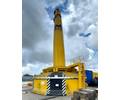As subsea projects continue to increase in size and complexity, they are also more frequently executed in deepwater and harsh environments. As well as having the vessels and ROVs with the capabilities to execute the scopes, and the expert people to develop the technologies and to manage larger and more complex projects at greater depths, new technologies are required to be introduced to meet these challenges.
Deepwater surface-to-seabed projects today are typically at depths of 1,500-2,000m and an increasing number are at depths of up to 3,000m. HPHT wells, the composition of the hydrocarbons and the harsh environments require new technologies to be developed to meet the challenges of operating at these depths. At the same time, these technologies must enhance safety, improve productivity, and achieve cost reductions.
As well as extending the high-end capability of vessels to deploy pipelines and associated seabed infrastructure at such depths, these advances range across many enabling and production technologies, including pipelines, risers, welding and remote intervention.
To develop new fields in ever deeper water, pipeline technology is required to meet the challenges of longer tie-backs, flow assurance and corrosive products. These advances also call for compatible advances in welding technology.
That’s why Subsea 7 has an extensive welding R&D program to enhance fatigue life and improve the quality of performance across a range of pipeline materials. Subsea 7 has recently extended its global pipeline development center in Glasgow to help support Subsea 7’s full range of pipeline installation methods and the procedures required to meet the exacting standards of deepwater.
To meet a wide range of field characteristics such as water depth, environmental conditions and hydrocarbon composition a range of technologies is required for risers. Hybrid, single, grouped SLOR and Steel Catenary Risers have all been developed by Subsea 7 in recent years.
The latest riser development, the Buoy Supported Riser (BSR) concept, was developed in partnership with Petrobras and will be deployed for the first time in the Brazilian pre-salt Guara and Lula fields. The BSR offers the advantage of being able to accommodate a large number of risers into a single FPSO facility by gathering these initially through a series of sub-surface buoys before being hooked-up to the FPSO.
Looking to the future, composite materials such as carbon fiber are being considered as an alternative material to conventional carbon steel for risers, offering both strength and weight savings.
Finally, the challenges posed by deepwater subsea system architecture and the need for Life-of-Field maintenance demand reliable, high-technology remote intervention solutions. There have been many pioneering developments of ROVs and remote intervention technology over the last 30 years. Our most recent innovation is the development of the advanced hovering autonomous inspection vehicle (AIV). This vehicle, and the associated inspection and monitoring sensor technology, will provide an industry step-change for future underwater operations. OE
Steve Wisely has served as Subsea 7’s Executive VP of Commercial since January 2011. Wisely has held multiple positions within Subsea 7 and its predecessor companies including Regional Vice President for Asia Pacific and later VP of Global Business Acquisition. He holds a degree in Quantity Surveying from the Robert Gordon Institute of Technology in Aberdeen.



